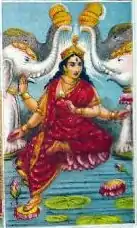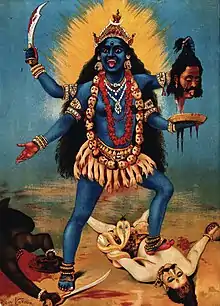Kamalatmika
In Hinduism, Kamala (Sanskrit: कमला) or Kamalatmika (Sanskrit: कमलात्मिका) is the Devi in the fullness of her graceful aspect. She is believed as the tenth and last Mahavidya ("great wisdom") and a form of Goddess Parvati.[1]
| Kamala | |
|---|---|
| Member of The Ten Mahavidyas | |
 | |
| Devanagari | कमला |
| Sanskrit transliteration | Kamalaa |
| Affiliation | Devi, Mahavidya, Parvati |
| Mount | Lotus, 4 elephants |
| Consort | Shiva as Kamal |
Iconography
Kamalatmika has a golden complexion. She is being bathed by four large elephants, who pour kalashas (jars) of amrita (nectar) over her. She has four hands. In two hands, she holds two lotuses and her other two hands are in abhayamudra (gesture of giving assurance) and varamudra (gesture of conferring boons) respectively. She is shown as seated in padmasana (lotus posture) on a lotus,[1] symbol of purity. Kamala and Sri Laksmi are different goddess.
Shiva purana says,
“daśamaḥ kamalaḥ śambhurbhuktimuktiphalapradaḥ । kamalā girijā tatra svabhaktaparipālinī ।। 11 ete daśamitāḥ śaivā avatārāssukhapradāḥ । bhuktimuktipradāścaiva bhaktānāṃ sarvadāssatām ।।” (Shiva Purana 3:17:11-12)
“Tenth incarnation of Shambhu is known as ‘Kamala (कमल)’ the bestower of joy here and liberation hereafter; and GirijA’s manifestation there is called ‘kamalA (कमला)’ who takes all care of her devotees. These are the ten manifestations of Shiva and Shakti, the giver of happiness, bestower of material comforts here and liberation hereafter to their devotees”.
Notes
- Kinsley, David R. (1997). Tantric Visions of the Divine Feminine: the Ten Mahāvidyās. Berkeley: University of California Press. p. 223. ISBN 0-520-20498-0.
Further reading
- Hindu Goddesses: Vision of the Divine Feminine in the Hindu Religious Traditions (ISBN 81-208-0379-5) by David Kinsley
Iconography
Kamalatmika has a golden complexion. She is being bathed by four large elephants, who pour kalashas (jars) of amrita (nectar) over her. She has four hands. In two hands, she holds two lotuses and her other two hands are in abhayamudra (gesture of giving assurance) and varamudra (gesture of conferring boons) respectively. She is shown as seated in padmasana (lotus posture) on a lotus,[1] symbol of purity. Kamala and Sri Laksmi are different goddesses.
Shiva purana says, “daśamaḥ kamalaḥ śambhurbhuktimuktiphalapradaḥ । kamalā girijā tatra svabhaktaparipālinī ।। 11 ete daśamitāḥ śaivā avatārāssukhapradāḥ । bhuktimuktipradāścaiva bhaktānāṃ sarvadāssatām ।।” (Shiva Purana 3:17:11-12)
“Tenth incarnation of Shambhu is known as ‘Kamala (कमल)’ the bestower of joy here and liberation hereafter; and Girijā’s manifestation there is called ‘Kamalā (कमला)’ who takes all care of her devotees. These are the ten manifestations of Shiva and Shakti, the giver of happiness, bestower of material comforts here and liberation hereafter to their devotees”.
Notes
Further reading
- Hindu Goddesses: Vision of the Divine Feminine in the Hindu Religious Traditions (ISBN 81-208-0379-5) by David Kinsley


